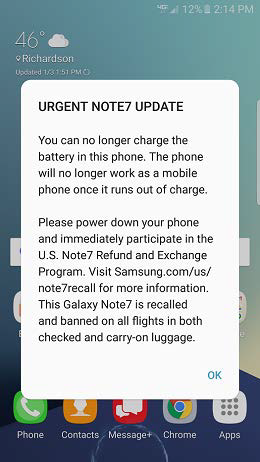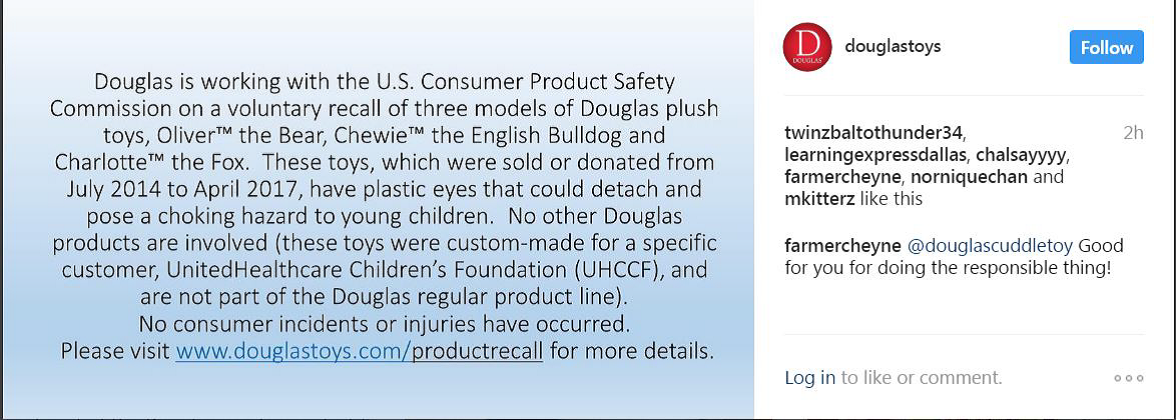Companies are expected to use any and all social media and mobile platforms on which the company maintains a presence including, but not limited to, Facebook, Twitter, YouTube, and Instagram, to notify consumers of the recall. Companies are encouraged to use paid advertising on social media. A Guide to Best Practices for Communicating Recalls on Social Media can also be found in Appendix D of The Recall Handbook.
Requirements for social media notifications:
- Use the terms “recall” and “safety” in the social media messaging about the recall.
- Keep it concise (#Recall hashtag, product name, hazard, remedy).
- Link directly to the dedicated recall webpage from Facebook, Twitter, Instagram Story or another social media notification.
- Use photos to increase priority on social media feeds and recall views.
- Make the recall a featured post, if possible.
- Use direct messaging to answer recall questions from consumers.
- Use videos to give even greater priority on the various platforms, where possible.
Best Practices for Communicating Recall Information on Social Media
Use of Organic vs. Paid Ads on Social Media
- Organic ads: posts get shared by users (free).
- Paid ads show up as a result of targeting the demographic that likely purchased the product (user demographic, interests, geographic location). The costs for engaging in social media advertising are typically much less than comparable radio, television, or print advertising.
- Facebook allows segmentation targeting by relationship status, age location, interests, and more.
- LinkedIn allows segmentation targeting by industry, company size, function, seniority, location, and language preference.
- Twitter allows segmenting based on language, follower, device, behavior, tailored audiences, keyword, and geographic location.
- Snapchat ads – Select from pre-defined audiences, age, location, device type, and advanced demographics like household income and parental status.
Recalling companies should have their staff or a PR agency monitor activity to respond to questions and comments.
Baby Trend:
Cabrinha:
How should you respond to comments/inquiries on social media?
- Firms should acknowledge customer inquiries by responding on the social media platform at least once.
- If the inquiry requires further communication with the customer, direct the conversation off social media by providing a phone number or email to allow the customer to contact the firm’s customer service team directly.
Should recalls be shared on blogs/advertorial/forums?
- Firms are encouraged to share information about the recall on virtual bulletin boards and through established “blogging” networks (subject to review and approval by CPSC staff).
- If a blogger reviewed the product before the recall, reach out and ask them to post recall information.
How can retailers help announce a recall?
- Firms should encourage retailers to post the recall on their website and use social media platforms.
- Some retailers have loyalty/reward cards that will enable direct contact with consumers who purchased the recalled product. Firms should encourage retailers to use that information to send consumers the recall notice via email or text message. Please follow the appropriate regulations.
What if the recalled product has its own app?
- Some consumer products come with or operate using an app. This feature enables firms to send consumers a recall message directly. Some examples are Apple and Android cell phones, wireless fitness trackers, watches and off-road vehicles.
- Messages can go to all users with the installed app.
- Send brief messages to communicate the recall.
- Provide messages that pop up on a phone with action needed to remove the message.
- Make sure messages can be tracked.
- There are several types of messages: pop-ups, badges, and banners.
Recalled firms are encouraged to work with the CPSC’s Office of Compliance to develop an agreed upon social media plan that is implemented each time you put a corrective action plan into effect.


Social Media Examples
Facebook:


Twitter:



Instagram:


Pinterest:
Updated 9/2021 Compliance



